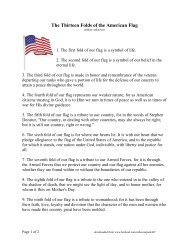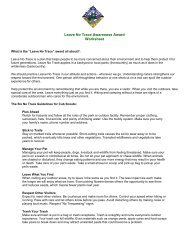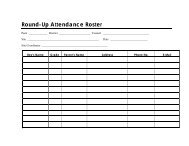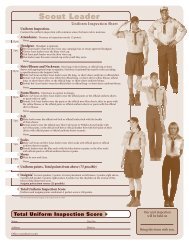BSA Guide To Safe Scouting 34416 - Hot4CAD Online
BSA Guide To Safe Scouting 34416 - Hot4CAD Online
BSA Guide To Safe Scouting 34416 - Hot4CAD Online
- No tags were found...
You also want an ePaper? Increase the reach of your titles
YUMPU automatically turns print PDFs into web optimized ePapers that Google loves.
Classification ofSwimming AbilityThe swimmer and beginner classification tests definedin <strong>Safe</strong> Swim Defense may be administered at the unit levelfollowing procedures specified in Aquatics Supervision,No. 34346.Swim classification tests for multiunit district and councilaquatics activities, such as day or resident camps, are generallyconducted on-site by supervisory personnel for those activities.Councils may arrange for swim classification tests conductedby council-approved aquatics resource people prior tocamp as outlined in section V of Camp Program and PropertyManagement, No 20-290. When swim tests are conductedoff-site prior to the camp session, the camp aquatics directorretains the right to review or retest any or all participants.Distance and CompetitiveSwimming in Open WaterThe following policies apply when distance swimmingis conducted outside the confines of a normal <strong>Safe</strong> SwimDefense area.• The environment for an open-water swim must conformto <strong>Safe</strong> Swim Defense guidelines regarding hazardssuch as submerged trees, currents, and boat traffic,as well as water quality, depth, and clarity.• Each individual swimmer, or at most a buddy pair,may be accompanied by a rowboat with two peopleonboard—one skilled in controlling the boat and theother trained in basic water rescue—equipped with areaching device and flotation aid, continuously watchingthe swimmers.• Alternatively, a closed circuit may be established whereall swimmers are constantly in reach of safety personnelstrategically positioned at fixed points on anchored boats,the shore, or piers. Each participant swims with a buddy,and the number and spacing of the swimmers in thewater should not exceed the capacity of the watchers toeasily count the swimmers as they move from one zoneto another.• Some competitive swimming events, such as triathlons,also cover long distances. Long-distance swimming racesare not approved for Cub Scouts or Boy Scouts, but VarsityScouts and Venturers may participate in triathlon trainingand competitive events. All swimming activities conductedby Varsity Scout teams or Venturing crews must conformto <strong>Safe</strong> Swim Defense guidelines. Individual Varsity Scoutsand Venturers may participate in outside triathlon eventssanctioned by USA Triathlon.Snorkeling in Open WaterAll ability groups may use snorkeling equipment withinconfined areas when following all <strong>Safe</strong> Swim Defensepolicies, including visibility for underwater swimming.Snorkeling is a swimming activity in which one must abideby <strong>Safe</strong> Swim Defense policies, but the following additionsto <strong>Safe</strong> Swim Defense apply when snorkeling is conducted inopen water. “Open water” denotes a temporary swimming areaof flexible extent in a natural body of water that may or maynot be close to shore.Qualified Supervision: In addition to <strong>Safe</strong> Swim Defensetraining and the 21-year-old minimum age, the supervisormust be an experienced snorkeler. At a minimum, the supervisormust possess skills and knowledge matching the Snorkeling<strong>BSA</strong> Award and have experience with environments similar tothose of the planned activity.Participant Ability: All participants in open-watersnorkeling must either complete Snorkeling <strong>BSA</strong> requirementsor be a certified scuba diver.Equipment: All snorkeling equipment must be properlyfitted and in good repair. Use of individual flotation devices(inflatable snorkeling vests or life jackets) is required wheneverthere is a noticeable current or swells, when the bottom is notvisible from the surface due to vegetation or limited visibilitybeyond 8 feet, or when the activity is greater than 50 yardsfrom shore or craft. A dive flag is required in areas shared byboats. Local regulations specifying the size of the flag and howfar snorkelers may be from it must be followed. Weight beltsmay not be worn unless the participant has scuba certification.Dive boats should be equipped with radios and first-aid kits,and should deploy safety lines.Additional guidance on application of <strong>Safe</strong> SwimDefense principles to snorkeling may be found in AquaticsSupervision, No. 34346, and Snorkeling <strong>Safe</strong>ty, No. 19-176,at www.scouting.org/filestore/pdf/19-176.pdf.<strong>BSA</strong> Scuba PolicyThe <strong>BSA</strong> scuba policy recognizes scuba industry standardsand implements them by using outside agencies fortraining and certification.Training and SupervisionAny person possessing, displaying, or using scuba (selfcontainedunderwater breathing apparatus) in connectionwith any <strong>Scouting</strong>-related activity must be either currentlycertified by a recognized agency or enrolled in an instructionalscuba program, such as Scuba <strong>BSA</strong> or Scuba Divingmerit badge, which must be conducted by an insured recreationaldiving instructor in good standing with a recognizedagency and approved by the council.10The online version of the <strong>Guide</strong> to <strong>Safe</strong> <strong>Scouting</strong> is updated quarterly.Go to http://www.scouting.org/Healthand<strong>Safe</strong>ty/GSS.aspx.








